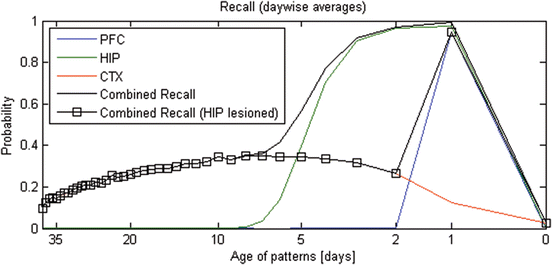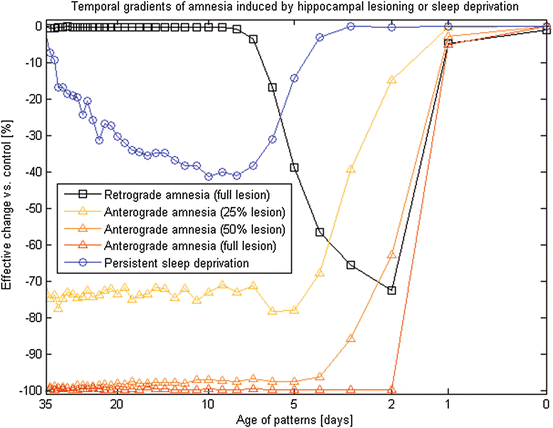Fig. 1
From prefrontal working memory to long-term neocortical memory. The four panels show the three simulation phases (1–3) and their active components, as well as the configuration during cued recall (4). Activity in the cortical areas is organized into hypercolumns, while hippocampal activity is sparser, pattern-separated and lacks columnar organization

Fig. 2
The simulation cycle with its three alternating phases, named perception, reflection and sleep. Online learning occurs only during perception
4 Results
The three modeled brain regions learn and forget dynamically over time, as can be seen by plotting the probability of successful recall for each stage (Fig. 3). For added clarity, Recall was averaged (daywise) for patterns of the same age. Also note that the x-axis of Fig. 3 is logarithmic. The PFC reliably stores only the most recent patterns of the current day (age = 1d), while HIP can recall patterns for about a week. CTX memories can last for over a month, but consolidation is highly competitive as not all patterns are replayed/reinstated often enough: About a third of all patterns become consolidated into neocortical long-term memory. This dynamic can be biased, however, by introducing a plasticity modulation (e.g. relevance signal) which temporarily boosts hippocampal encoding. This, in turn, raises replay strength and frequency and thus improves consolidation odds and speed. On average, maximum systems consolidation is reached after about a week. For patterns between 2 and 5 days old, combined recall drops sharply following simulated hippocampal lesioning.


Fig. 3
The probability of successful recall plotted against age of patterns, for the three different modeled brain regions (PFC, HIP, and CTX)
Retrograde amnesia is temporally graded, confirming experimental lesion data [1, 18, 19], see Fig. 4. Very recent pattern recall is not impacted as it is supported by working memory (PFC). Anterograde amnesia is flat, because future consolidation is permanently impaired, as well as hippocampal performance. This amnesia pattern is markedly different from simulated sleep deprivation (a consistent 50 % reduction in simulated sleep), which decreases system consolidation performance notably, but leaves hippocampal memory functional, so the anterograde effect becomes noticeable only after about 5 days. Also, because of reduced overwriting, cortical forgetting is also lower, which reduces the degree of amnesia for very old patterns.


Fig. 4
Amnesia gradients, expressed as percentage wise performance changes, following partial or complete hippocampal lesions (deletion of a fraction of HIP units)
5 Conclusion
Our model produces the necessary stochastic dynamics for episodic memory consolidation. Working Memory can hold patterns for less than a day and cortical learning is much too slow for any useful online learning from brief percepts, yet autonomous consolidation through the hippocampal system can yield stable cortical long-term memories, some of which can be recalled from cortex more than a month later.
Despite significant simplifications, the model show many of the properties and characteristics observed experimentally. These include competitive consolidation, retrograde facilitation after impaired acquisition (not specifically shown here), as well as typical amnesia effects after simulated hippocampal lesions.
Stay updated, free articles. Join our Telegram channel

Full access? Get Clinical Tree






